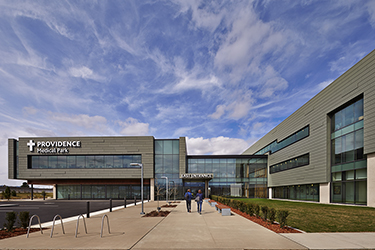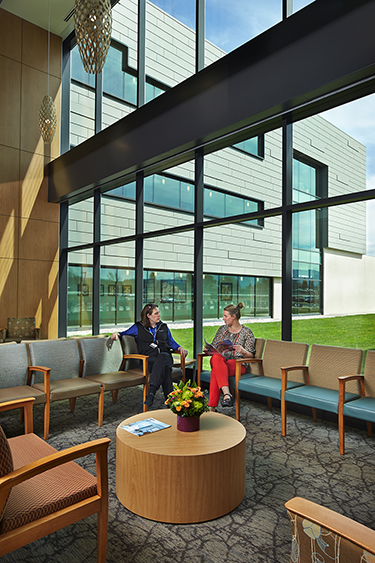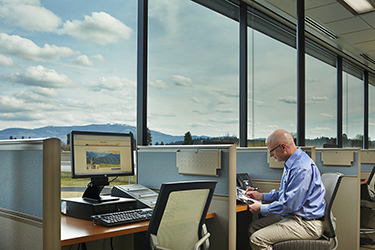|
Subscribe / Renew |
|
|
Contact Us |
|
| ► Subscribe to our Free Weekly Newsletter | |
| home | Welcome, sign in or click here to subscribe. | login |
Construction
| |
 |
July 24, 2014
How lean helped hyper-fast project to cross the finish line
Mahlum

Goodfriend
|

Perzik
|
Providence Medical Group sought a new facility that would provide a “one-stop shopping” patient experience for the growing community of Spokane Valley in Eastern Washington.
They envisioned a comfortable place where a patient could visit a primary care doctor, have diagnostic tests, pick up a prescription, and follow up with a specialist all in the same day under one roof.
The design team led by Mahlum Architects utilized lean concepts in their medical planning, site and facility design to create a hybrid facility that reduces wait times for patients, permits quicker diagnoses and allows faster treatment, resulting in better patient outcomes.
The new center, called Providence Medical Park, opened in April.
“Comprehensive outpatient centers are the way of the future, focusing on convenience and affordability,” says Mike Wilson, CEO of Providence Health Care.
For Providence’s new facility, the spirit of this philosophy was imbued throughout its operational model as well as its design and construction approach.
An easy entrance
Patients and visitors benefit from the team’s lean-planning approach even before they enter the facility. Prominently located off the interstate, the 134,000-square-foot center has an intuitive entry sequence to easily move patients from the freeway to the lobby and into an exam room.
Two clearly marked entry drives direct patients to the clinic side of the building on the west or to the urgent care/ambulatory surgery entry on the east. Groves of native trees and plazas flank the entries, providing moments of “decompression” between the building and parking.
Once inside Providence Medical Park, a central hub with multiple registration and orientation stations greets visitors. The building revolves around the hub — major circulation routes, elevator cores and stairwells feed into this area, while adjacent lounge spaces overlook the landscape. Aided by transparency across the space, this straightforward organization quickly directs patients to their destinations.
Outside each care department welcome desks and sitting areas mark the point of arrival. These spaces also provide quieter, dispersed waiting areas across the facility.
Lean operations
Key project stakeholders — from provider and nurse groups to departmental management and Providence leadership — embraced lean medical planning principles from the start of the project.
An intensive weeklong workshop defined the center’s goals and explored ways to ensure that the design would support improved workflows and provide coordinated, quality care. “3P” — production, preparation and process — sessions identified targeted metrics for wait times, patient visit times and projected volumes. By eliminating nonessential actions and setting aspirations based upon desired clinical outcomes, the design of the medical center would help improve care quality and the patient experience.
To ensure lean theories would work for users, the design team mocked up exam rooms at full scale to develop a repeatable model that is efficient and user friendly. Double-sided exam rooms now support an onstage/offstage clinic model that keeps care team members in close proximity to patients and allows patients to “self-room.”
This organization also permits staff workstations to be closely located to patient rooms while benefiting from extensive daylight.
Design strategies
To simplify operations and maintenance and maximize future tenant flexibility, the team organized the building program into two wings connected by support services. Primary and specialty care fill a three-story wing and robust clinical technologies fill a two-story wing.
This configuration allows mechanical and electrical systems to be tailored to specific programmatic requirements such as air changes, hours of operation and emergency power. Thus, clinical areas have the supporting systems they require and the building uses less energy overall.
The building systems chassis is designed to be easily modified, allowing clinical services to evolve as future needs and medical care and practices change.
Finishes were chosen for timeless aesthetics and low maintenance — concrete masonry anchor zinc metal panels, windows are set in aluminum storefront frames, and wood veneer accents add warmth.
Hyper-fast schedule
As lean medical planning and operations were embraced by staff and client leaders, the design and construction team deployed lean methods to drastically reduce design and delivery of the medical center to just 22 months. While this hyper-fast project schedule would allow the new building to capitalize on market conditions, it also created a number of challenges from the outset.
Mahlum worked hand-in-hand with the general contractor Bouten Construction to develop a tailored fast-track approach to design and construction with a focus on limiting exposure to change orders and implementation risks.
There were two equally important goals of this approach: Offer the clinical users as much time as possible to make careful design decisions, and at the same time allow the general contractor to begin construction as early as possible.
Mahlum met both goals by basing the design process on three strategies: strategically sequencing the building systems and bidding, implementing a lean design process with clinicians, and harnessing the power of building-information modeling software.
Smart sequencing
To get construction documents to the general contractor as quickly as possible, Mahlum reconsidered the typical approach to designing and documenting a medical office building.
First, the team separated the exterior envelope from the interior construction and documented these components separately. Second, and perhaps more importantly, the team developed creative solutions to achieve elements that required extensive time to fabricate and deliver to the site.
One long-lead element that required creative thinking was the time required for the steel detailer to calculate the drawings prior to steel fabrication. In response, the team moved concrete shear walls to allow their construction while the steel was being detailed.
Once steel was delivered, the concrete shear walls were completed and steel erection rapidly completed. Thus, the team shaved five weeks from the construction schedule.
In addition, the rooftop air-handling units were sized and designed ahead of the balance of mechanical systems, allowing an early order by the subcontractor. The early delivery was timed to coincide with the completion of steel erection.
The elevators were also documented and procured early to allow installation prior to the start of interior construction. When the hoistway enclosure was complete, the elevator subcontractor began installation the next week, saving the cost of a temporary construction lift.
Since the interior tenant improvement package was bid well after the start of core and shell construction, interior doors and frames were procured early. This would allow interior partition framing to begin while the building permit was under review.
Door frames, doors and hardware were all coordinated and documented early by the design team. When the building permit was issued, the general contractor could start interior partition framing with the door frames in place.
Uses for BIM
Mahlum leveraged BIM to ensure the finished interior environment of Providence Medical Park was not compromised by poorly coordinated building systems. The digital platform provided immediate, continuous project design feedback that was high-quality, reliable, integrated and coordinated.
With BIM, the team could customize specific casework for medical equipment and quickly resolve building system conflicts with the general contractor and vendors. Real-time digital information about each piece of medical equipment was shared among project team members, such as electrical or plumbing subcontractors, to ensure accurate modeling, coordination and installation.
Erik Goodfriend is the director of Mahlum’s Healthcare Studio and served as principal-in-charge of the Providence Medical Park. David Perzik is an associate at Mahlum. He served as project manager and medical planner for the Providence Medical Park.
Other Stories:
- Seattle Children’s psychiatry unit will help kids feel at home
- What’s next for the UW medical center
- Student health centers evolving to provide more holistic care
- Behavioral health projects present unique challenges
- How to design and build a plastic surgery center in less than 5 months
- Hospitals have a lot to learn from lean
- You can protect patients with clean construction





